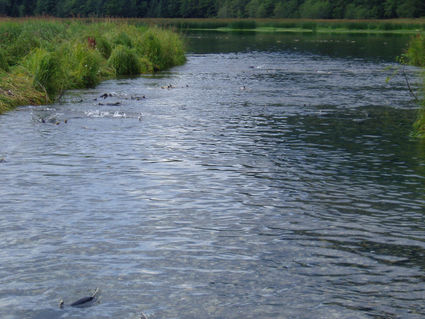WCA fisheries program hoping to restore salmon sources

photo courtesy of ADFG
Salmon spawn last year at Crystal Creek on Mitkof Island, adjacent to Blind Slough. Wrangell Cooperative Association held its first community workshop for a new fisheries program, which intends to eventually restore traditional watersheds in the area.
Members of Wrangell Cooperative Association and the wider community were invited out to an informational workshop Tuesday night, introducing them to the Tribe's latest program.
Alongside its Transportation and IGAP (see article inside) offices, the Subsistence Fisheries Management Program intends to improve quality of life and opportunity for tribal members, in this case through salmon restoration in traditional watersheds.
Brian Ashton was invited by WCA to head the new program, which at the start of 2015 secured $189,000 in grant funding through the Bureau of Indian Affairs.
The goals of the fisheries program are to build capacity, provide educational opportunities for local youth, enhance local subsistence and ultimately produce the next generation of fisheries managers.
In the long term, Ashton explained the program would like to rehabilitate salmon populations at several nearby watersheds, in particular Mill Creek, the Bradfield River, Aaron Creek and Andrew Creek.
In the most immediate future, the program is seeking funding to monitor sockeye salmon escapement at Mill Creek and Virginia Lake for several years, building on United States Forest Service data collected up until 2003.
Over the past several decades, a half-dozen attempts have been made to enhance stock at the site, including construction of a fish ladder in 1980, stream channel modifications in 1988 and nutrient enrichment in the 1990s.
Fertilization efforts ceased in 2002, and monitoring soon after. Before making a further attempt Ashton said the program would need to collect data first. Two crews would resume data collection, which would include a census of the annual escapement of adult and jack sockeye, using double-redundant video net weirs; an estimation of age and sex; and monitoring passage of adults past Mill Creek falls number two, and possibly three and four.
In 2003 USFS tracked adult escapement at the creek with radio tags, and found 78 of 100 to have completed the 1,200 yard journey to Virginia Lake. The fish took just over four days to complete the trip, which included scaling four falls. The fish that made it to the lake had a 60 percent successful spawning rate.
"We've put in funding to basically fill those gaps," he said. In addition, water quality, light penetration and other factors at the creek would be measured a couple of times each week. The crews would require six seasonal workers, hired from among local youth, as well as biologists. The timeline for the project will be dependent on grants. Labor will be the primary cost, and equipment will have to be acquired.
"We're going to need more cost-effective measures to do things," Ashton added. This would include making better use of automated cameras to reduce labor requirements.
"There's a lot of things to look at," he said. The data collected will eventually inform a decision whether to attempt restoration of the water system."Maybe we'll find something in there that's a limiting factor that you can't do anything about."
The end aim is to increase output for local subsistence users, particularly those unable to make the trip out to the Stikine River.
"The next step is looking at the Bradfield," Ashton projected.
His program is currently preparing a grant application to evaluate the feasibility of restoring that river, once a major king salmon source. Aaron Creek was another candidate for restoration, given its proximity to the island.
In addition to council members and members of the Tribe, local fishermen and other interested residents sat in on the meeting, and were invited to share their perspectives on the program.
As a gillnetter and member of the regional aquaculture association, Chris Guggenbickler pointed out demand for federal funding is doubtless going to increase as state sources become unavailable. He questioned whether the stock at Mill Creek and Virginia Lake were worth the effort of restoring, given the potential for fewer available resources.
"The funding that we're going after is very specific," Ashton explained, set aside specifically for building tribal capacities.
Guggenbickler encouraged WCA to involve multiple parties, including Alaska Department of Fish and Game and USFS, people who are knowledgable about fisheries management, the area, escapements and permitting requirements.
"I do feel we need to have direction," agreed Tammi Meissner, a member of the WCA council. The presentation soon slipped into talk about possible restoration sites and management policies.
"We really appreciate you guys' input," Meissner told the fishermen afterward.
"We learned a lot," agreed Richard Oliver, recently elected president of the WCA Tribal Council.
From here the program will continue to gather input from tribal members and the community.









Reader Comments(0)